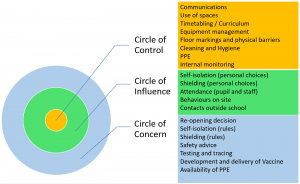Establishing a strong culture of safety and risk awareness against a background of phased return to school | Think Piece Two (8.5.20)
Lead author: Bryony Green
Culture and risk
As schools consider their plans for re-opening, this piece considers the importance of a strong culture of safety and risk awareness in this situation. In the absence yet of a detailed plan and timeframe for re-opening, it seeks to support school leaders to identify and grow such a culture. In the thinking below, there is an exploration of how a strong culture of health and safety should be established and maintained and how achieving risk benefit is not just about preventing activities from taking place, but also accepting that risk is inherent in returning to school in a world of COVID-19. Against this backdrop the effective and proactive management of this risk will help us to plan a way forward.
Shifting safety concerns ahead of education
In more normal times, the function of Health and Safety in schools is to serve the educational goals of school leaders – to keep children, staff and others safe (with legal compliance) whilst optimising the educational experience. It is values-driven – as a service, it protects those who aren’t able to protect themselves, and supports equity in the safe access of pupils to educational experiences.
The current pandemic has turned our normal experience of Health and Safety for schools on its head. Schools partial opening and social distancing have become the norm whilst the educational offer has needed to rapidly evolve to fit this structure.
The response has been remarkable, particularly the shift to virtual learning. However, this is not viable in the medium to long term and regardless of any permanent developments that may be attributable to our current arrangements, there is a strong educational and economic imperative for children to return to school, not least for wellbeing considerations. A truly child-centred recovery seeks to transfer the design of pupil experience back to our educational leaders without compromising safety.
A Culture of Safety
Alongside personal perception of risk, the shared values, attitudes and beliefs inform our individual behaviours and actions. Collectively these shape organisational cultures and as leaders we have a responsibility to influence positively the culture within our own organisations. In novel and high stress situations, the safety culture of an organisation will play a significant part in influencing the success and sustainability of our plans. If the safety of pupils and staff is of prime importance, then the culture has to be right.
A strong culture of Health and Safety is reflected in the shared sense of responsibility across groups of people and is visible in the small day-to-day decisions, action and interactions: modelling behaviours; talking positively about safety; not walking past issues. Where this exists teams have quickly adjusted to take responsibilities and ownership for new control measures – for example with all staff sharing tasks such as simple ‘clean as you go’ actions.
In addition, it’s important to recognise and consider the human response to this changing environment when preparing for return. A culture which strongly values both how safe people are and how safe they feel – will be essential to a smooth and successful return.
Building a consensus around the need to return and engagement in planning will provide valuable contributions to the details: ensuring they meet need (emotional as well as physical) and foster a shared ownership of personal responsibilities within the safety framework.
Understanding and applying risk
Ordinarily, good practice can be found in proportionality. In educational terms, sometimes it is desirable to provide children exposure to risk if this can be done in a controlled and measured way, without being overly risk averse. This is known as risk benefit.
In such a novel situation such as the current pandemic, our ability to gauge level of risk is severely reduced and we have to take more risk averse decisions. Broadly speaking, until the development of a widely available vaccine or other treatment, three main control measures exist:
- social distancing (avoiding transmission);
- hygiene (reducing exposure to the virus and reducing the route to infection)
- testing (to inform a more sophisticated approach to social distancing)
https://medical.mit.edu/three-ways-to-protect
In a crisis, the blunt application of the first two control measures, including the closure of schools, has significantly reduced the transmission of infection within the population and therefore the number of people with Covid-19.
Whilst timing and details of re-opening has not been confirmed, we do know that any return will be phased, with pupils returning to their learning in school at different times. It’s essential that time is spent now in considering preparation for re-opening across a range of scenarios and preparing for those identified.
A more sophisticated assessment of the risk and control measures might therefore involve considering the ‘Circle of Control’ concept, developed by Stephen Covey and breaking down detailed measures into each level.

In a situation where there are not (yet) clearly defined phases, it’s helpful to consider and develop our own definitions. In order to do this, we can model a range of scenarios within our own environment and we can look outside our sector for other experiences.
To support the development of appropriate scenarios, it’s helpful to first understand to what degree can schools re-open and still retain an acceptable measure of social distancing (as we currently understand it)?
This of course is dependent on a range of physical and environmental factors that are unique to each school and would still require a comprehensive suite of control measures.

Trusts are assessing their answers to this question and the answer will be influenced strongly by local factors and be affected by a range of factors including classroom size, corridor width, number of toilets etc. One trust has come up with a figure that is as low as 25%.
If we accept that the return of students at any level within this range does not satisfy the educational imperative, we need to consider then either what additional controls would be required in order to manage the increasing risk or how strong the educational need might need to be to outweigh the risk.
Risk tolerance is set at organisational level (determined by risk appetite) and will require re-assessment by Trusts in light of the current situation, paying particular attention to national policy and expert advice. It is recommended that against a range of identified risks, acceptable outcomes (in line with risk tolerance) are agreed and bespoke or local mitigations need to ensure they meet these agreed outcomes.
Additionally, the personal risk awareness and tolerance of staff will be an influencing factor in novel situations like this phased return. It might be helpful to consider the intersection created by our ability to control risk and our risk tolerance when thinking about the number of children who could be accommodated.

Applying risk and judgement: some scenarios
We then need to consider a range of scenarios for re-opening in order to really test what control measures we might be able to meaningfully apply, and that might have impact on risk. It is helpful to align this thinking with the five tests being applied by the UK Government as they consider how and when to lift the lockdown:
- Making sure the NHS can cope
- A ‘sustained and consistent’ fall in the daily death rate
- Rate of infection decreasing to ‘manageable levels’
- Ensuring supply of tests and PPE can meet future demand
- Being confident any adjustments would not risk a second peak
A local assessment can then be made to understand, against a range of scenarios (such as the quartiles identified below and current guidance), what is required to increase the number of people within schools.

The approach taken to implement any additional controls, alongside required support for staff and monitoring will be dependent on the culture in place in any organisation. Consideration of the factors that will impact on the success of these measures (or the risks that might compromise the intention) is essential to provide a robust and sustainable response. The culture will support implementation of control measures and at the same time, the successful implementation of control measures (for example having an adequate stock of any identified PPE) will sustain confidence and culture.
The value of pursuing a clear communication strategy through this activity cannot be understated. Seeking input and feedback and sharing plans in detail as they are finalised will be essential to ensure staff, pupils and parents are confident that the culture of health and safety is mature and will help to protect and keep them safe when they return to school.
Summary
The culture of safety and risk in any organisation is reflective of the wider organisational mission, values and culture and has a direct impact on how children learn.
Our duty, to lead a child-centred recovery in which we transition back to school without compromising safety, is reliant on our culture of safety and risk. Success will ensure everyone within our schools feel safe and are safe (through our collective actions).
Queen Street Group
This think piece is for discussion put out by the group as a whole and should not be seen as a reflection of specific policies adopted by any of the named member Trusts.
8th May 2020
1 The QSG member Trusts educate 214,000 pupils across 393 schools. The members are:
Academies Enterprise Trust; Astrea Academy Trust; Brooke Weston Trust; Cabot Learning Federation; Creative Education Trust; Dixons City Academy Trust; Education South West; The First Federation Trust; Future Academies Trust; Lead Academy Trust; Leigh Academies Trust; Oasis Community Learning; Ormiston Academies Trust; South Farnham Educational Trust; Unity Schools Partnership; Ventrus Limited; The White Horse Federation.
